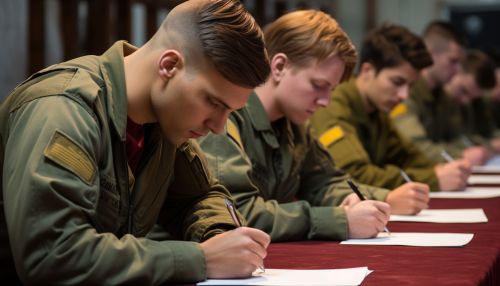Army Beta
Introduction
The Army Beta is a non-verbal intelligence test that was developed during World War I by the United States Army. It was designed to measure the intellectual capacity of illiterate, unschooled, and non-English speaking adults and adolescents. The test was part of a larger series of psychological tests known as the Army Alpha and Beta tests, which were used to assess the mental ability of military recruits.
Development
The Army Beta test was developed in response to the need for a method of assessing the intellectual capacity of individuals who were unable to read or write, or who did not speak English. This need arose during World War I, when the U.S. Army was recruiting large numbers of individuals from diverse backgrounds. The Army Alpha test, which was a written test, was not suitable for these individuals, so the Army Beta test was developed as a non-verbal alternative.
The test was developed by a team of psychologists led by Robert M. Yerkes, who was the president of the American Psychological Association at the time. The team included other prominent psychologists such as Lewis M. Terman, who was known for his work on intelligence testing.
Structure and Content
The Army Beta test consists of seven different types of non-verbal tasks, each designed to measure a different aspect of intellectual functioning. These tasks include picture completion, digit symbol substitution, block counting, cube analysis, pictorial analogies, geometric construction, and number checking.
In the picture completion task, the individual is shown a series of pictures, each of which is missing a part. The individual is required to identify the missing part. In the digit symbol substitution task, the individual is shown a series of symbols that are paired with numbers, and is required to match the symbols with the correct numbers.
The block counting task requires the individual to count the number of blocks in a stack, while the cube analysis task requires the individual to determine how a series of cubes would look if they were arranged in a certain way. The pictorial analogies task involves identifying the relationship between two pictures and then finding a third picture that has the same relationship with a fourth picture. The geometric construction task requires the individual to construct a specific shape using a set of geometric pieces, and the number checking task involves checking a series of numbers for errors.
Administration and Scoring
The Army Beta test is administered in a group setting, with the instructions for each task being given orally by the test administrator. The test is timed, with the individual being given a certain amount of time to complete each task.
The scoring of the Army Beta test is based on the number of tasks that the individual is able to complete correctly within the given time limit. The scores from the seven tasks are combined to give a total score, which is then converted into a percentile rank.
Validity and Reliability
The Army Beta test has been found to have good validity and reliability. Studies have shown that the test is a valid measure of non-verbal intellectual functioning, and that it has good test-retest reliability, meaning that individuals tend to get similar scores when they take the test on different occasions.
However, like all psychological tests, the Army Beta test is not perfect. It has been criticized for its cultural bias, as some of the tasks may be more familiar to individuals from certain cultural backgrounds. In addition, the test may not be a valid measure of intellectual functioning in individuals with certain types of cognitive impairments.
Legacy
Despite these limitations, the Army Beta test has had a significant impact on the field of psychological testing. It was one of the first non-verbal intelligence tests, and it set a precedent for the development of later non-verbal tests such as the Raven's Progressive Matrices.
The Army Beta test also played a significant role in the development of group testing methods. The methods used to administer and score the test were innovative for their time, and they have been used as a model for later group tests.
See Also


